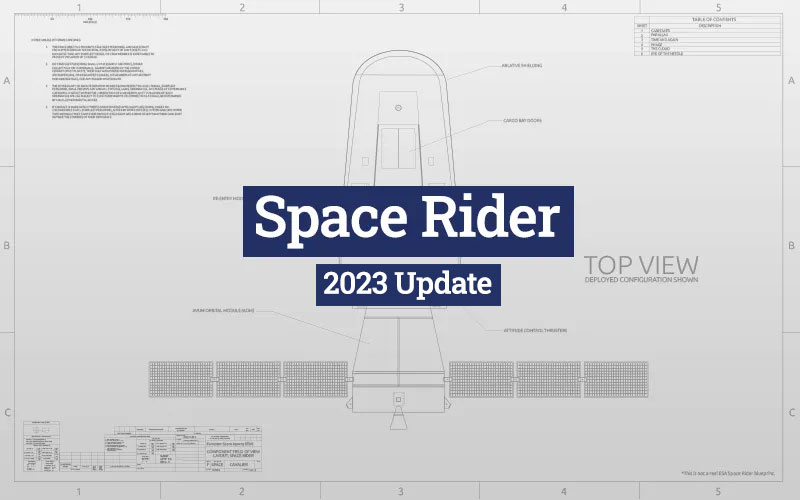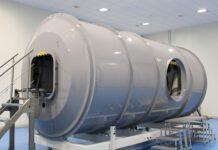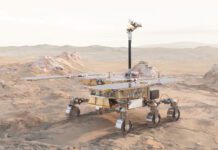
The maiden flight of ESA’s reusable Space Rider spacecraft is now slated for the fourth quarter of 2024 aboard a Vega-C rocket. This represents a slip of around 12 months from the last update that European Spaceflight published almost exactly one year ago.
Speaking to European Spaceflight, ESA Space Rider Programme Manager Dante Galli shed light on where the Space Rider programme currently is today and what its future looks like. He also shared some thoughts on REV1, a joint effort between Thales Alenia Space and Space Cargo Unlimited to develop a vehicle capable of hosting in-orbit manufacturing that is based heavily on Space Rider.
Where is the ESA Space Rider project at the moment?
We had the closure of the Critical Design Review at the system level on October 2022. We are consolidating the last aspects of the design in the early month of 2023, while in parallel holding several Manufacturing Readiness Reviews at subsystem and units/components level. This will be followed by the validation and qualification testing sequence. All the other streams of activities (Ground Segment, Landing Site, Payloads for the maiden and subsequent flights) are running as well at a good pace and we are preparing the drop test campaign(s) for the validation of the Guidance, Navigation, and Control “under-parafoil” Phase.
When is the first subscale drop test scheduled for 2023? And how many drop tests in total are likely to occur?
What we call “scaled-down” tests will start by March/April 2023, and we plan to have around 100 tests. There will then be, rather towards the second half of the year, another set of drop tests with a full-scale platform representative in terms of mass distribution and moments of inertia. All these tests will pave the way for the final full-scale drop test loop, with a fully representative test vehicle.
How big will the subscale test vehicles be and how close to the final design of Space Rider will they represent?
The first round of scaled-down tests is intended to validate the GNC algorithms and will be based on a 150 kg test article, which will be representative (although clearly scaled) of mass distribution, barycentre position, and moments of inertia. It will also include a scaled parafoil. This will be improved for the open-loop and closed-loop test campaigns in a full-scale platform for further refinement of all the algorithms and parameters to arrive at a full-size test article that will be fully representative not only of mass and moments of inertia but also of shape, landing gear, and mechanisms, etc… This will be a fundamental test towards qualification and readiness for the maiden flight.
How much funding did the project receive at the 2022 Ministerial Conference and is it sufficient to complete the development of Space Rider?
Overall we had a very good result for which we really grateful to participating states and Italy in particular, as a major contributor, for providing the necessary support to allow us to complete the development of Space Rider including some additional activities, like further activities concerning the reusability aspect, preparatory activities for the subsequent flight, and enlargement of potential services to the payloads.
How many customers have committed to launching aboard Space Rider? And how many flights does this represent?
The ESA Announcement of Opportunity issued in September 2021 resulted in 40+ potential institutional and commercial customer entities showing interest in flying aboard Space Rider. Since then, several further requests for flights have been considered. We appreciate ESA’s continuous effort to promote the project among potential space industry and institutional partners and extending this initiative to non-traditional space industrial entities whose business would sensibly take advantage of the services offered by the project. Interestingly, we noted that several customers expressed their interest to consider long-term agreements to secure their payloads accommodation on the vehicle for additional subsequent flights. Memorandums of Understanding to state mutual formal commitment to flights are being finalized with several customers and they include to date potential payload flights on Space Rider missions up to flight number 3.
From what I understand, once Space Rider is operational it will be handed over to a commercial operator. Why not keep operations with ESA?
The maiden flight will be indeed operated by ESA. Then, we plan to have a transition phase during the subsequent flights up to the full operational capability of the vehicle. The details on who will be in charge of the commercial operations of the vehicle, under which exploitation rules/principia, and the various roles and responsibilities will be proposed and finalized by the end of this year.
Has there been any additional discussion about an upgraded Space Rider vehicle and what that might be?
With the reasonable logic to focus on the maiden flight and preparation of the first re-flight, CM`22 indeed focused on these primary objectives. Several concepts for possible SR evolutions are anyway on the table and the idea is to gather as much information as possible and “return of experience” from the current vehicle – mainly in terms of re-entry from orbit and reusability technologies – and to capitalize on them to ensure Space Rider can be a building block for the future space transportation sector in Europe.
What do you think about Thales and Space Cargo Unlimited utilizing the work being done for Space Rider to build the REV1 spacecraft?
First of all, the Space Rider programme will be the first European reusable orbital vehicle, planned to have a maiden flight by 2024 and it must be said that there can`t be any “REV1 initiative” without having Space Rider flying first, as clearly REV1 concept is based on the work done for Space Rider.
I see the fact that there are other commercial initiatives as a confirmation of the fact that ESA and the Space Rider project are going in the right direction in establishing European reusable orbital vehicles and services capability. Moreover, REV.1 is addressing a very specific application: in-space manufacturing. Conversely, Space Rider is conceived to be a versatile in-orbit platform for a broad range of applications: microgravity experiments for life science and physical science, in-orbit demonstration and validation of new technologies, satellite deployment, in-orbit assembly, and in-orbit services, etc… It’s a long list on which in-space manufacturing is also included. Thus, I see Space Rider and REV1 working more in a complementary way for the emerging LEO commercial applications market rather than in a competitive way.







